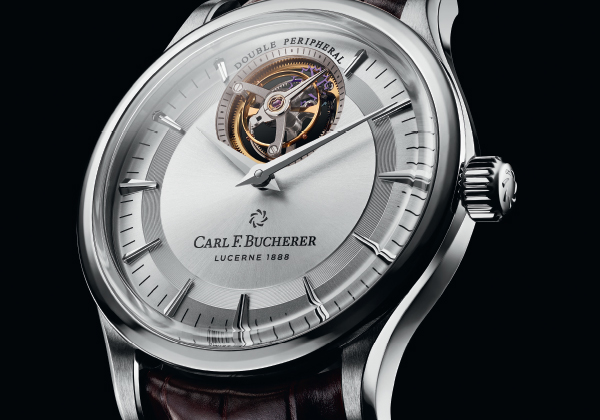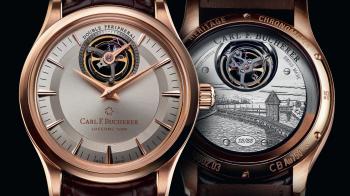At first sight, there’s nothing special about it: a tourbillon, positioned at 12 o’clock, with two central hands. But the very fact that nothing leaps out bears witness to the fact that Carl F. Bucherer has designed a movement that uses peripheral rotation in an extremely ingenious way.
Carl F. Bucherer’s oscillating weight sets it apart on the watchmaking scene: it really is unusual. There’s a bit of fun numerology to add to the mystery, too: the oscillating weight as we know it today is believed to have been invented in 1777 by Perrelet, while Carl F. Bucherer was founded in 1888, a gap of precisely 111 years – and quite some (r)evolution in the art of winding a movement.
Eccentric - in every sense of the word
The traditional system attributed to Perrelet features a solid half-moon that rotates on its own axis at the back of the calibre as the watch moves, thus winding the barrel. This is known as the oscillating weight, or rotor. It is to be found in almost all automatic watches on the market, along with micro-rotors: these fulfil exactly the same function, but are smaller in size and incorporated into the thickness of the movement. Carl F. Bucherer’s distinctive achievement was to move this heavy weight, which almost always hides half the movement, towards the edge – and make it a ring rather than a half-moon. This allows the entire movement to be admired, and enables the entire timepiece to be slimmed down. The system is not specific to Carl F. Bucherer; Patek Philippe had investigated it in the 1960s. However, only Carl F. Bucherer has made this feature its hallmark by first industrialising and then manufacturing it. The brand’s CFB A1000 calibre was unveiled in 2008.
The principle in question is used in the Manero Tourbillon Double Peripheral, constituting the first peripheral system. The ‘peripheral’ part of the name is self-explanatory, while the term ‘double’, refers to the fact that Carl F. Bucherer used exactly the same principle for the tourbillon – and that’s what makes the timepiece so singular.

The Art of Freewheeling
The movement providing the power was tailor-made for the piece: the CFB T3000 calibre. It marshals the same principle that lies behind the peripheral oscillating weight and applies it to the tourbillon, which is carried along by a peripheral carriage. The latter is thus not moved by a central pinion, but by a system of almost invisible peripheral gears. Shorn of its traditional gear train, the tourbillon appears in the sleekest form ever designed. This exercise in style is very much in the same spirit as the flying tourbillon (which has no upper bridge and is thus held in place solely by its base) – and takes it to the next level.
The revolution Carl F. Bucherer has brought about in this timepiece relates not to the tourbillon’s essential principle, but to the way in which it is implemented. In terms of technique, the approach is fully in keeping with the brand’s expertise in peripheral rotation, developed over a ten-year period between 2008 and the CFB A1000 movement and 2018, with the launch of the Manero Tourbillon Double Peripheral in the firm’s 130th anniversary year.
The timepiece also keeps all its promises in terms of precision, boasting COSC chronometer certification. One should also recall that this tourbillon also features a stop-seconds system, causing the tourbillon to halt while the time is being set and thus making it possible to adjust the piece to the exact second. It’s a fully-mastered, coherent timepiece with genuine technical and aesthetic added value that is obvious at first sight – a tourbillon for connoisseurs that will not fail to make its mark.
*This year GMT Magazine and WorldTempus have embarked on the ambitious project of summarising the last 20 years of the Tourbillon in The Millennium Watch Book - Tourbillons, a big, beautifully laid out coffee table book. This article is an extract. The Millennium Watch Book - Tourbillons is available on www.the-watch-book.com, in French and English.





